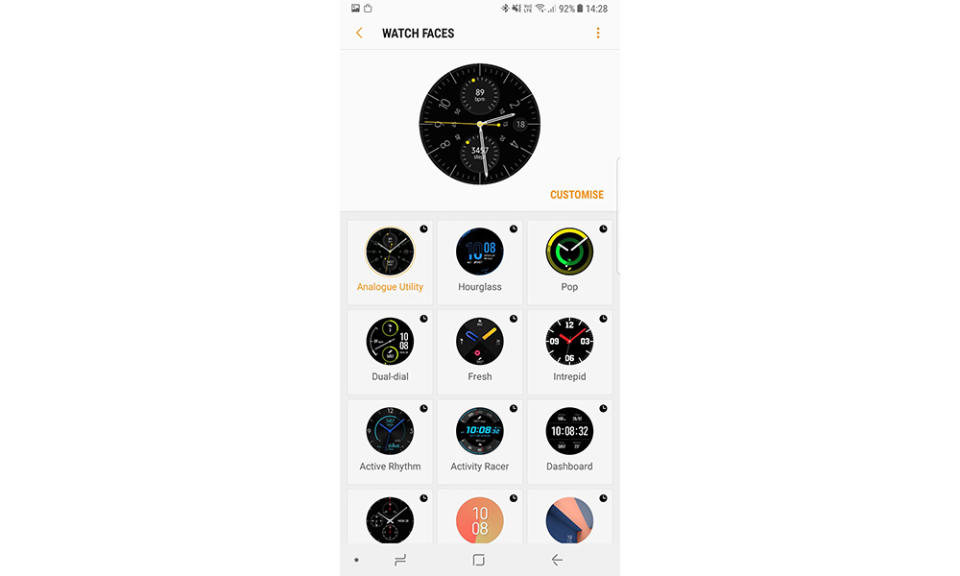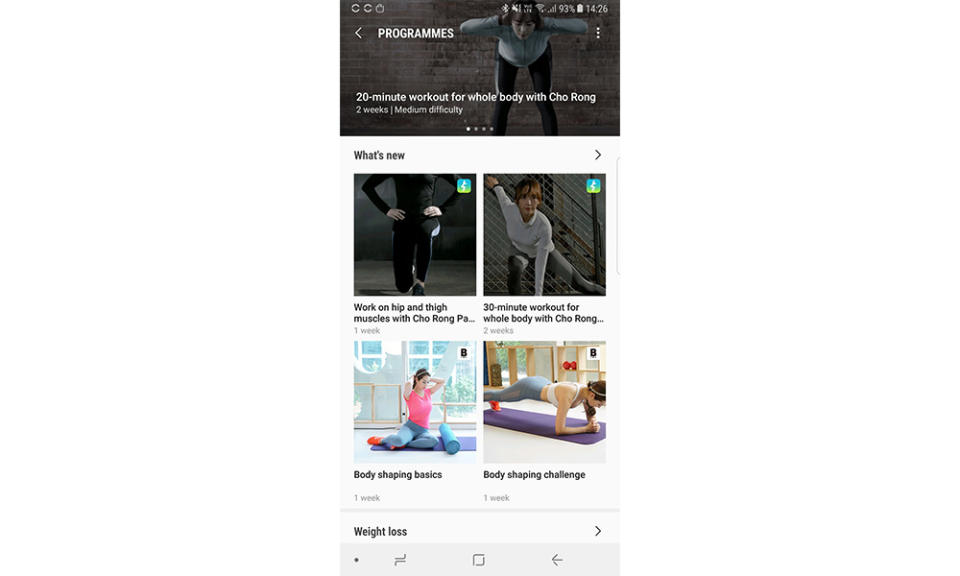Samsung Gear Sport review: Impeccable hardware, but messaging needs work
The Gear Sport is Samsung’s latest smartwatch. Despite its name, it’s not only for fitness enthusiasts. The Gear Sport is smaller, thinner and lighter than the Gear S3, which makes it an airier smartwatch to wear. That lightness comes from shaving a couple of features off. The Gear Sport doesn’t have the S3’s LTE connection. Samsung Pay works fine with NFC terminals, but the Gear Sport can’t pay via magnetic strip.
The price has been shaved as well. At S$448, the Gear Sport costs less than the Gear S3. The Gear S3 Frontier smartwatch with LTE retails at S$598, while the non-LTE Gear S3 retails at S$548.
The Gear Sport is a handsome smartwatch
The stainless steel body feels solid and well constructed. Its circular chassis looks more like a traditional watch than the squarish Apple Watch, which looks more like a computer on the wrist. The strap is comfortable, but the double keepers make it hard to put on.
The 1.2-inch AMOLED screen is one of the best things about the Gear Sport. The display is bright and crisp with vibrant colors. The screen turns off when you’re not looking at it, but you can turn on a ‘always on’ state that consumes more battery life. That’s how I use the Gear Sport and it lasts two days on average before I have to recharge it.
Setting up the Gear Sport with a Samsung Galaxy Note8 was easy. When I turned the Gear Sport on, the Note8 notified me that it detected the Gear Sport and asked if I wanted to pair them.

The charging dock with the Gear Sport works fine, but I wish it were flat instead. When you charge the Gear Sport with the straps undone, the straps dangle and it looks a mess.
The Gear Sport is mostly easy to use

The Gear Sport is mostly easy to use, but you’ll occasionally bump against unpolished details that jolt you out of flow. You can interact with the Gear Sport via the touchscreen, or the two buttons (for Back and Home). You can speak to the S Voice digital assistant, which had mixed success recognizing my Singaporean accent.
You can also use the clever rotating bezel that was first introduced on the Gear S2. Turn the bezel left and you’ll see notifications (swiping right on the screen does the same thing). Turn right to scroll through a series of widgets, and see info like calories burned, heart rate, and calendar. Tap the Home button and you’ll go into the apps screen, turn the bezel to quickly scroll through your apps.

Changing watch faces is easy. You can do it either on the Gear Sport or in the Samsung Gear app; you can also buy third-party watch faces. It’s fun to have such a wide selection of watch faces. In contrast, the Apple Watch has a limited number of faces and no third-party ones at all.

The Gear Sport runs Tizen OS, not Android Wear, and the Tizen app store is barren. Spotify, however, is on Tizen, and provides one of the Gear Sport’s best features. You can download Spotify playlists to the Gear Sport via Wi-Fi and listen to music without your phone. The Gear Sport has 4GB of internal storage, which can store about 500 songs.
The Gear Sport is responsive and using it is a mostly positive experience. But there are details that increase friction and reduce ease. For example, there’s no easy way to edit widgets in the Samsung Gear app. You’ll have to remove or re-arrange them on the watch face.

A few interactions need you to tap ‘yes’ or ‘no’ on the screen. The touch targets are small, by the sides of the screen.
The Gear Sport also gives you options that you can’t complete on the watch. After you clear all notifications, a Settings button appears. When you tap that the Gear Sport asks you to change settings on your phone. When you get your week’s activity summary, you’re asked to check that on the phone too.
Messaging apps are a problem
These rough edges might be minor bothers for most, but there’s one that’s more troublesome. Tizen doesn’t handle app messaging well. You can see single messages from apps like WhatsApp and Hangouts, and send canned or transcribed replies.
But when you have multiple missed messages in a thread, the Gear Sport can only show you the latest one. SMS works fine, you’ll be able to see every message you’ve missed, but not with data messaging apps. It seems this is a problem with some non-Android Wear smartwatches pairing with Android smartphones. The Garmin Vivoactive 3, which runs its own OS, has the same problem with Android, but not with iOS.


Working out with the Gear Sport
The Gear Sport was good at tracking my daily activities. It automatically tracks longer walks and congratulates you for them. If you wear it to sleep, it’ll automatically track your sleep. I found it to be accurate at knowing when I doze off and wake up.
I liked that it nudged me to start moving after I’ve been at my desk for too long, but it would be better if I could change my options. The Gear Sport will ask you to stretch your arms, rotate your torso, or squat, and you can’t switch them out. To its credit, even if you tap ‘no’ then walk around, the Gear Sport will still congratulate you.

If you’re looking for a program to hit at the gym, you can download workouts via the Fit Evolution Pro app. The workouts sync with the Gear Sport, you watch the trainer on the phone and the Gear Sport keeps time. You can schedule these workouts within the Samsung Health app.
I’ve compared the Gear Sport’s daily heart rate tracking with the Apple Watch, and the accuracy is on par. But the Gear Sport misses scheduled measurements. I’ve set it to measure my heart rate ‘frequently,’ according to the watch, that’s every 10 minutes. But I’ve often discovered that it hasn’t taken a reading for longer than that. In the Samsung Health app, I have missing heart rates for up to an hour at a time.

The Gear Sport also failed to measure heart rate a couple of times. Both times I was sweaty, and after cleaning the sensor, the Gear Sport could take my heart rate again.
When it came to steady state exercise, the Gear Sport was slower to update heart rates than the Apple Watch and a Polar treadmill’s heart rate monitor. The latter two were usually five beats within each other, the Gear Sport could be up to ten beats behind.
The Gear Sport failed to keep pace during high-intensity intervals, and was as much as 40 beats behind at one point. To be fair, the Garmin Vivoactive 3 also had problems keeping up with interval training.
It comes down to WhatsApp

The Gear Sport is a handsome device that feels well-made, and is a demonstration of Samsung’s hardware mastery. It’s smaller, lighter and slimmer than the Gear S3, so even if you’re not an athlete, you can consider the Gear Sport for its deftness.
The Gear Sport provides adequate tracking for the everyday user, and the heart rate tracker lands in the ballpark for steady state exercises like running. But it can’t keep up with intervals, and it sometimes forgets to take measurements in everyday life. This makes it hard to recommend the Gear Sport for the hardcore athlete, who will want accurate stats like resting and maximum heart rates.
Tizen is smooth and intuitive, but it needs polish. Most of the bumpiness is forgivable, but it’s a hassle when you can’t see multiple messages in a thread for data messaging apps like WhatsApp. To be fair, this may not entirely be on Tizen. The Garmin Vivoactive 3, which runs its own OS, also has the same problem on Android. And SMS works fine. But no matter who takes the blame, broken messaging makes it hard to recommend the Gear Sport.


